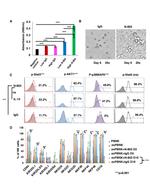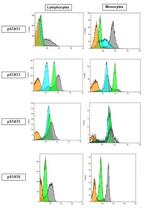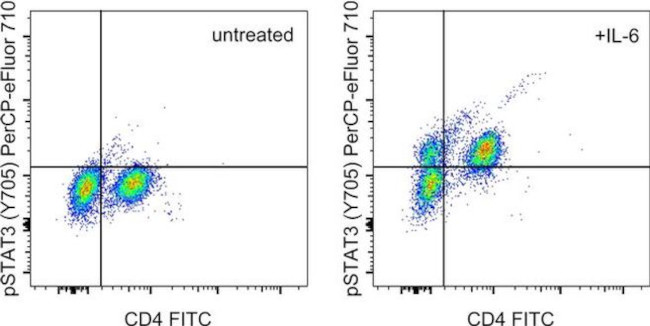Search Thermo Fisher Scientific
Invitrogen
Phospho-STAT3 (Tyr705) Monoclonal Antibody (LUVNKLA), PerCP-eFluor™ 710, eBioscience™
FIGURE: 1 / 3
Phospho-STAT3 (Tyr705) Antibody (46-9033-42) in Flow



Product Details
46-9033-42
Species Reactivity
Published species
Host/Isotype
Recommended Isotype Control
Class
Type
Clone
Conjugate
Excitation/Emission Max
Form
Concentration
Purification
Storage buffer
Contains
Storage conditions
Shipping conditions
RRID
Product Specific Information
Description: This LUVNKLA monoclonal antibody recognizes human and mouse signal transducer and activator of transcription 3 (STAT3) when phosphorylated on tyrosine 705 (Y705). The STAT family represents seven transcription factors (STATs 1, 2, 3, 4, 5A, 5B, and 6) that are involved in many cellular processes including apoptosis, cell differentiation, and proliferation in a cell type- and cytokine-specific manner. STAT proteins are activated by ligand binding to cytokine receptors that associate with Janus kinase (JAK) family members.
Following their phosphorylation by JAKs, STAT proteins translocate to the nucleus where they bind to DNA and regulate transcription of specific genes in a cell type- and cytokine-specific manner. STAT3 is activated downstream of numerous cytokines including interferons, IL-5, IL-6, IL-10, and LIF. STAT3 is important for the differentiation of Th17 cells and mediates a variety of cellular processes including cell growth and survival. The importance of STAT3 is highlighted by both loss-of-function and gain-of-function mutations. Deletion of STAT3 in T cells results in decreased IL-6- and IL-2-mediated proliferation, while deletion of STAT3 in neutrophils and macrophages results in increased susceptibility to LPS-induced endotoxic shock and increased production of the pro-inflammatory cytokines IL-6 and TNF alpha. Hyper STAT3 activity is associated with poor prognosis of many different cancers.
Applications Reported: This LUVNKLA antibody has been reported for use in flow cytometric analysis.
Applications Tested: This LUVNKLA antibody has been pre-diluted and tested by flow cytometric analysis of stimulated normal human peripheral blood cells. This may be used at 5 µL (0.06 µg) per test. A test is defined as the amount (µg) of antibody that will stain a cell sample in a final volume of 100 µL. Cell number should be determined empirically but can range from 10^5 to 10^8 cells/test.
PerCP-eFluor™ 710 emits at 710 nm and is excited with the blue laser (488 nm); it can be used in place of PerCP-Cyanine5.5. We recommend using a 710/50 bandpass filter, however, the 695/40 bandpass filter is an acceptable alternative. Please make sure that your instrument is capable of detecting this fluorochrome.
Light sensitivity: This tandem dye is sensitive to photo-induced oxidation. Please protect this vial and stained samples from light.
Fixation: Samples can be stored in IC Fixation Buffer (Product # 00-8222) (100 µL of cell sample + 100 µL of IC Fixation Buffer) or 1-step Fix/Lyse Solution (Product # 00-5333) for up to 3 days in the dark at 4°C with minimal impact on brightness and FRET efficiency/compensation. Some generalizations regarding fluorophore performance after fixation can be made, but clone specific performance should be determined empirically.
Excitation: 488 nm; Emission: 710 nm; Laser: Blue Laser.
Target Information
STAT3 belongs to the family of STAT (signal transducers and activators of transcription) proteins which are phosphorylated by receptor associated kinases, translocate to the nucleus, and act as transcription factors in response to cytokines and growth factors. Coactivators such as CREB-binding protein are required for the transcriptional activation by STAT3. STAT3 can also be activated by Interferon-alpha, Interferon-gamma, EGF, PDGF and IL6. Phosphorylation on tyrosine 705 by JAK1 and JAK2 is essential for STAT3 dimer formation, nuclear translocation, and DNA binding activity. In humans, the STAT3 gene is located on the q arm of chromosome 17. STAT3 has been shown to be activated by IFN-alpha but not IFN-beta. The transcription factors associated with STAT3 are c-Jun and cyclic AMP-responsive enhancer binding protein (CREB). STAT3 mediates the expression of a variety of genes in response to cell stimuli, and thus plays a key role in many cellular processes such as cell growth and apoptosis. The small GTPase Rac1 has been shown to bind and regulate the activity of STAT3 while the PIAS3 protein is a specific inhibitor of STAT3. Three alternatively spliced transcript variants encoding distinct isoforms of STAT3 have been described. Deletion of the STAT3 gene in knock-out mice was lethal at the early embryonic stage.
For Research Use Only. Not for use in diagnostic procedures. Not for resale without express authorization.
How to use the Panel Builder
Watch the video to learn how to use the Invitrogen Flow Cytometry Panel Builder to build your next flow cytometry panel in 5 easy steps.
Bioinformatics
Protein Aliases: acute phase response factor; Acute-phase response factor; DNA-binding protein APRF; FLJ20882; MGC16063; Signal transducer and activator of transcription 3; signal transducer and activator of transcription 3 (acute-phase response factor); STAT
Gene Aliases: 1110034C02Rik; ADMIO; ADMIO1; APRF; AW109958; HIES; STAT3
UniProt ID: (Human) P40763, (Mouse) P42227
Entrez Gene ID: (Human) 6774, (Mouse) 20848

Performance Guarantee
If an Invitrogen™ antibody doesn't perform as described on our website or datasheet,we'll replace the product at no cost to you, or provide you with a credit for a future purchase.*
Learn more
We're here to help
Get expert recommendations for common problems or connect directly with an on staff expert for technical assistance related to applications, equipment and general product use.
Contact tech support

